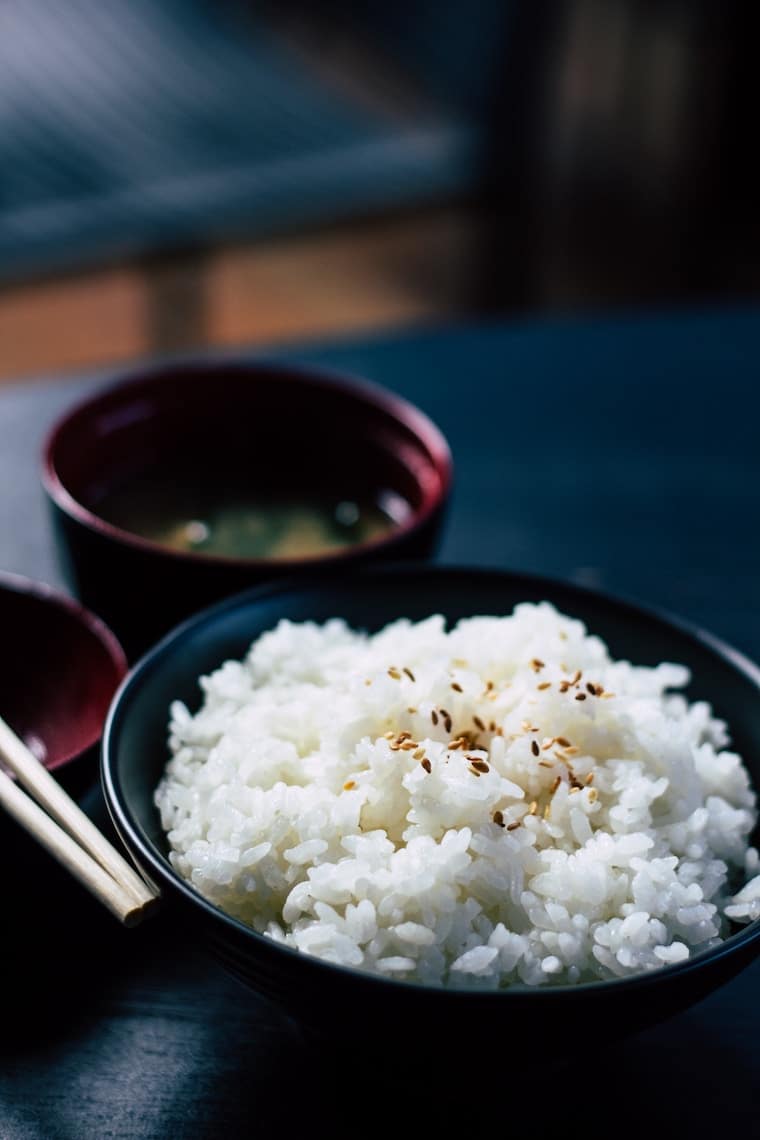I share with you tips on how to cook resistant starches for weight loss and other health benefits.
Click here to read part 1 of this resistant starch series on resistant starches and various health benefits.
One fascinating thing about cooking resistant starches is that there are certain cooking techniques that can be used to control the resistant starch content in foods. Some of these techniques include:
- Changing the pH by adding acids
- Cooking/heating time and temperature
- Altering the number of heating and cooling cycles you implement.
Naturally, different types of rice will have varying levels of amylose (resistant starch) content ranging from 0-35%. Digestibility of cooked rice starch is typically influenced by the amount of amylose, with higher amylose content resulting in slower digestion and lower glycemic index of the rice. However, after cooking rice, there is typically less than 3% resistant starch that will not get digested.
Ripening
For certain foods like banana which are typically not cooked, allowing the fruit to ripen into a yellow colour will result in lower resistant starches because of their conversion into regular, digestible starches. That’s why green bananas are known to contain very high levels of resistant starch.
The Addition of Heat/Acid
Heat treatment (i.e. cooking/boiling) combined with the addition of an acid to starchy food (i.e. lemon juice) has been a method for increasing resistant starch content in food.
Cooling Process
A more commonly used food preparation method that has a significant effect on changing resistant starch content is starch retrogradation; otherwise known as “yesterday’s rice” (i.e. cooked rice which is stored overnight). The starch retrogradation cooling process is responsible for enhancing resistant starch content in specific foods after cooking, in which type 3 resistant starch is produced. Once these starches are cooled after being cooked, there is formation of a new structure that is digestion-resistant. The optimal temperature for retrogradation is between 1-25°C and longer storage time enables more retrogradation to take place.
A clinical randomized, single-blind crossover study investigated the effect of cooling cooked white rice on resistant starch content and glycemic response in healthy subjects. Analysis of resistant starch was conducted on freshly cooked white rice (control rice), cooked white rice cooled for 10 hours at room temperature (test rice 1), and cooked white rice cooled for 24 hours at refrigeration temperature (i.e. 4°C) then reheated (test rice 2). Researchers found that with with equal amounts of rice, test rice 2 (cooled for 24 hours) exhibited the greatest resistant starch content. Test rice 2 reflected the “cook-cooling” method of starchy foods, and displayed significant reductions in glycemic response by decreasing the amount of available carbohydrates compared with freshly cooked control rice.
Recently, a group of researchers claimed that a new heating and cooling method for increasing resistant starch in foods could possibly “cut the number of calories absorbed by the body by more than half”. Depending on the variety of rice and method of processing, it was said that calories could be reduced by ~50-60%. This innovative method involved boiling water and adding 1 teaspoon of coconut oil to it, followed by adding ½ a cup of rice. The rice would be simmered in this liquid for 40 minutes or boiled for 20-25 minutes, then refrigerated for 12 hours. Researchers found that this method resulted in a 10 X greater increase in resistant starch compared to regularly cooked rice.
But how did coconut oil, cooking time and refrigeration work its magic? It was explained that the coconut oil (a lipid) entered starch granules during cooking, which resulted in structural alterations, making it more resistant to enzymatic breakdown and decreasing the amount of calories absorbed. The cooling part allowed the soluble, amylose portion of starch to escape the granules during gelatinization, and reheating the rice before eating was not shown to affect concentration of resistant starch. Similarly, a Korean study found that adding soybean and coconut oil into the cooking water before heating and storing in the fridge for 12 hours increased resistant starch content. Interestingly, resistant starch was higher when cooked using a saucepan compared to an electric cooker. However, between the japonica (Hopyeong) and indica (Thailand) rice used in this study, the indica rice cooked with soybean oil had the highest amount of resistant starch (type 3 and 5).
Tips for Cooling your Starchy Favourites
If you’re a regular consumer of rice, potatoes or pasta, try adopting a different cooking method by cooking these foods 1 or 2 days and cooling prior to consuming them. Ensuring that you cool down these foods in your fridge overnight or for a few days can increase their resistant starches. Moreover, based on data from rice, cooked and cooled foods still have higher resistant starch content after reheating. This is a simple way to increase your fiber intake since resistant starch is considered a form of fiber. By cooking your potatoes, rice or pasta 1-2 days before eating them, this will increase its resistant starch content.
The Bottom Line: Should I be adding resistant starches to my diet?
Resistant starch is a unique carb because it resists digestion and leads to several health benefits. While some foods naturally have more resistant starch compared to others, the method of preparing your food impacts the ultimate amount. Whether you’re considering whether to practice the “cooking-cooling-reheating” method for enhancing resistant starch, first make sure that you have adequate and/or high fiber in your typical diet. If you’re looking to enhance the fiber of some of your starchy foods, this is worth a try. You could add resistant starches to your diet through dietary foods sources or supplements. This includes potatoes, oats, green bananas, certain legumes, as well as cooked and then cooled potatoes and rice. Replacing simple carbohydrates with resistant starch may help improve the overall quality of your diet. However, you should try avoiding ramping up that fiber intake all of a sudden because it can cause a whole of GI discomfort and gas, and everyone’s experiences with resistant starch will definitely vary.
Many human studies display the promising health benefits with enhancement of resistant starch in the diet for improving insulin sensitivity, aiding digestion and reducing the glycemic response after a meal. Although this has been an active area of research and considerable progress has been made, we still need to determine how to best incorporate resistant starches in human diets before its full potential can be realized. Even though resistant starch is associated with some health benefits and may be one component of your lifestyle, consuming high concentrations of resistant starch won’t be the quick-fix solution to a healthy, balanced and sustainable diet for optimal health.
Click here to read part 1 of this resistant starch series on resistant starches and various health benefits.
Contribution By:
RD2B Rachel Shim

Abbey Sharp is a Registered Dietitian (RD), regulated by the Ontario College of Dietitians. She is a mom, YouTuber, Blogger, award winning cookbook author, media coach specializing in food and nutrition influencers, and a frequent contributor to national publications like Healthline and on national broadcast TV shows.










Julie @ Running in a Skirt says
How fascinating! I didn’t know the difference. I do know I need some starches in my life or I get cranky. 🙂
Abbey Sharp says
yes! I hear ya girl
Kym Mulvey says
Great article…If coconut oil works to convert the starch, will coconut milk or cream also work?
I need a reason to eat more coconut rice!!
Abbey Sharp says
I’ll have to get back to you on that!
Susan Collins says
This is SO interesting. It also indicates to me that we cook and eat food too quickly nowadays and don’t prepare food properly – like Sourdough Bread which needs at least a day and night to prepare properly. Growing up a frequent food on our table was ‘Bubble and Squeak’ a dish of LEFTOVER cooked cabbage, carrots and potatoes that had been in the fridge a day or two. Seems ‘leftover’ has had an undeservedly bad rep for too long now!
GiGi Eats says
Girl, I just love how scientific and informative you get! I have studied resistant starch in the past and it can be quite a healthy addition, it’s so interesting how food changes and can affect the body differently just by trying a different method of preparation!
Abbey Sharp says
Yeah such a cool area right!
Jill Conyers says
I always learn something new from your posts. That’s interesting about the cooked and cooled rice.
Abbey Sharp says
Aw so glad. Thanks Jill
Mikki says
Wow! What an interesting article. The part about letting the bananas ripe to help, that was pretty cool. I would have never thought to look into this.
Abbey Sharp says
Yeah! Cool stuff right!
Julie Stevens says
The riper the bananas the lower the resistant starch, pretty sure the point here is to eat them green thus getting more resistant starch.
Natalie says
Fascinating. So much interesting and helpful informations in one place. I still have so much to learn about food I eat everyday. Thanks Abbey
Abbey Sharp says
Aw thanks Natalie. So glad you find it helpful
Lindsey Pine says
I haven’t experimented with resistant starches yet, but really want to. Really want to try working with banana flour.
Abbey Sharp says
Yeah! Very cool right
Kelly says
Hi, I am assuming you drain the rice/potatoes after cooking, then cooling them for 12 or more hours before reheating right? Or do you cool in the water the rice/potatoes were cooked in? Thanks for any information on this. Very interesting!
Chrissy @ Snacking in Sneakers says
I’m fascinated by the concept of resistant starch! Is so interesting that heating/cooling can affect the way something is digested by our body.
Abbey Sharp says
Yeah totally cool. Got me nerding out
Jessica Levinson says
Interesting research on resistant starches! So informative! Great list of tips for cooking resistant starches too.
Abbey Sharp says
Thanks Jessica
s.durham says
I’ve searched extensively and hope you can answer my question. when cooling foods to increase their rs, should they be cooled in the water they were cooked in, or should they be rinsed and cooled minus the water?
tia.
Terrance says
No need to keep them in liquid. Just put into containers and fridge them.
Deborah Brooks says
wow I have never heard about most of this! Never thought to cook rice or pasta in advance!
Abbey Sharp says
Right! Super interesting
Jessica Kuepfer says
I love starches and love the people that advocate for them! Thanks for another awesome post. 🙂
Abbey Sharp says
Woot! Thanks Jessica
Chris Z. says
I’ve lost almost 30 pounds having switched to a vegan, resistant starch foraRd diet. I have more energy than I can ever remember as well. The health benefits of resistant starch is truly mind blowing. See Mary’s Mini diet and Dr. McDougall for even more info. And Abbey, this article was SUPER helpful!
Abbey Sharp says
So glad 🙂
Stacey Mattinson says
Looks like I’m in luck! I made a potato yesterday but wasn’t able to eat it until today – boom! Resistant starch to the rescue!
Abbey Sharp says
haha love it!
Rachel says
This is so interesting. You always have such informative posts!
Abbey Sharp says
AW thanks love
Emily @Sinful Nutrition says
I’ve been seeing a lot about resistant starches, but never really looking into the topic too much. Thanks for shedding some light on it for me!
Abbey Sharp says
Yeah! It’s super fascinating
Samantha says
It is so interesting! I’m learning so many new things from this post!
Abbey Sharp says
Yay! So glad
Rebecca says
this is so fascinating! I’ve never heard about this cooling concept, now I want rice 😉 thanks for sharing
Abbey Sharp says
Hahah right!